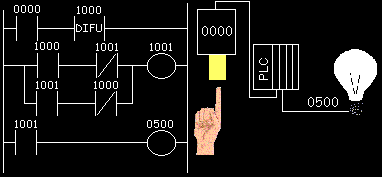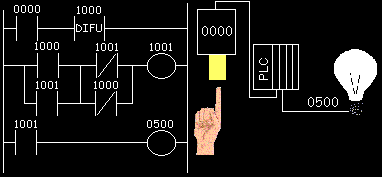OK, let's leave the branch out and do the same scan-by-scan explanation. Here are the rungs: (I left the 0500 coil out).
0000 1000
-| |-----|DIFU|-
1000 1001 1001
-| |---|/|--|--( )-
|
1001 1000 |
-| |---|/|--|
Start with 1001 OFF. It will remain OFF until 0000 comes ON.
In the scan in which 0000 first comes ON, 1000 will be ON. In the second rung, in the top parallel branch, 1000 is TRUE, NOT 1001 is TRUE, so the coil will be turned ON (TRUE).
In the next scan, 1000 will go OFF. In the secnd rung, in the top parallel branch, 1000 is FALSE and so is NOT 1001 (remember 1001 was turned ON during the last scan). In the bottom parallel branch, 1001 is TRUE, and NOT 1000 is also TRUE, so the coil remains in the ON state. This condition will prevail until something changes.
Now when 0000 changes back to OFF, nothing happens to 1000, so nothing changes in the second rung.
The next time 0000 goes ON, 1000 turns on again for one scan. During that scan, in the second rung, the top parallel branch, 1000 is TRUE, but NOT 1001 is FALSE (remember, 1001 is still ON). In the bottom parallel branch, 1001 is TRUE, but NOT 1000 is FALSE. Neither of the parallel branches are TRUE, so the 1001 coil is turned OFF.
During the next scan, in the top parallel branch, 1000 is FALSE and NOT 1001 is TRUE. In the bottom parallel branch, 1001 is FALSE, and NOT 1000 is TRUE. Again, both parallel branches are FALSE, so the 1001 coil remains OFF, and will continue to remain OFF until the next time 0000 goes from OFF to ON.






